Easy Steps to Start and Grow your Ecommerce Business in Dubai, UAE
How to Start & Grow Your Ecommerce Business in 2025
According to a report by Statista and eMarketer, online retail sales are projected to reach $6.51 trillion by 2026. That same report also says that ecommerce websites will claim around 22.3% of all retail sales.
Imagine a world where your online store anticipates your customers' desires before they even know them, delivering their purchases with unmatched speed and accuracy. Welcome to e-commerce in 2025—a future where artificial intelligence, augmented reality, and lightning-fast logistics redefine how we shop and sell. For business owners, this is the moment to seize the opportunity and tap into the multi billion dollar e-commerce market. Are you prepared to explore the strategies and technologies that will elevate your business in this fast-paced, innovative landscape? Let’s unlock the future and uncover the keys to e-commerce success in 2025.
Key Drivers of Ecommerce Growth in 2025
- Increasing internet penetration will open up new markets, particularly in developing countries where a significant portion of the population is just coming online.
- Rising smartphone usage propels mobile commerce to new heights, as consumers seek convenience and on-the-go shopping experiences.
- Changing consumer preferences, predominantly towards online shopping, will prompt retailers to transition from brick-and-mortar to ecommerce or a hybrid model.
- Advances in technology foster a high-speed, more secure, and immersive online shopping environment, pushing the boundaries of what's possible in ecommerce.
- Government initiatives and support, such as policies encouraging digital economies and investments in broadband infrastructure, will further catalyze ecommerce growth.
Key Takeaways from This Article
- E-commerce growth will continue to accelerate, with an expected CAGR of 14.7% through 2025.
- Mobile commerce will dominate, accounting for 72.9% of e-commerce sales.
- Personalization and customer experience will become paramount, leveraging AI and data analytics.
Without further delay, let’s jump into it!
Choosing The Right Ecommerce Platform For Your Business
Choosing the best e-commerce platform in the UAE is crucial for the success of your online business. With numerous options available, it's important to consider your specific needs and preferences. Here are some key factors to evaluate:
1. User-Friendliness:
- Intuitive Interface: The platform should be easy to navigate and use, even for those without technical expertise.
- Customizability: Look for a platform that allows you to personalize your online store's design and layout to reflect your brand identity.
- Mobile Optimization: Ensure your e-commerce platform is fully optimized for mobile devices, as a significant portion of online shopping occurs on smartphones and tablets.
2. Features and Functionality:
- Product Management: The platform should provide robust tools for managing your product catalog, including inventory tracking, pricing, and variations.
- Payment Processing: Choose a platform that integrates with popular payment gateways and offers secure payment options.
- Shipping and Fulfillment: Consider the platform's capabilities for handling shipping, returns, and order fulfillment.
- Marketing Tools: Look for integrated marketing features such as SEO tools, email marketing, and social media integration.
3. Scalability:
- Growth Potential: The platform should be able to accommodate your business growth and handle increasing traffic and sales volumes.
- Flexibility: Ensure the platform is adaptable to your changing needs and can integrate with other systems.
4. Pricing:
- Cost-Effectiveness: Compare pricing plans and fees to find a platform that fits your budget.
- Value for Money: Evaluate the features and benefits offered by each platform to determine if the cost is justified.
- Free Trial: Like most steps you take in starting an online business, you’ll want to be prepared with a set of questions that will help you make the right decision for your store. You can connect with sales and support staff to get your burning questions answered, or test out features yourself by starting a free trial.
5. Support and Customer Service:
- Reliability: Look for a platform with a proven track record of uptime and reliability.
- Responsive Support: Ensure the platform provides timely and helpful customer support.
6. Local Focus:
- UAE-Specific Features: Consider platforms that offer features tailored to the UAE market, such as language options and payment methods.
- Compliance: Ensure the platform complies with local regulations and laws.
Top 10 Ecommerce platforms in UAE - Noon.com: A leading UAE-based e-commerce platform offering a wide range of products, including electronics, fashion, home goods, and more. Known for its user-friendly interface, fast delivery, and competitive prices.
- Amazon.ae: The UAE branch of the global e-commerce giant, Amazon.ae offers a huge selection of products and reliable customer service.
- Namshi.com: A popular fashion e-commerce platform in the UAE, Namshi offers a curated collection of clothing, accessories, and beauty products.
- Cartlow: A pioneering app in the region that offers a hassle-free way to purchase certified and guaranteed clearance, open-box, and refurbished products at affordable prices.
- Go2Sell: A comprehensive e-commerce platform designed to help businesses of all sizes succeed in the UAE market.
- Mumzworld.com: A specialized e-commerce platform catering to mothers and children, offering a wide range of products from baby essentials to toys and maternity wear.
- Jumbo Electronics: A leading electronics retailer in the UAE, offering a wide range of electronic products, including smartphones, laptops, cameras, and home appliances.
- Sharaf DG: Another popular electronics retailer in the UAE, known for its competitive prices and wide product range.
Find Products That Will Sell in 2025
Finding the right products to sell is key to success in ecommerce. You can no longer create commodity or ‘me too’ products and expect success. Instead ask yourself ‘what problem is my product going to solve’ and ‘why would someone buy my product’ as opposed to all the others out there. Use data from Amazon reviews and forums to understand how to make better products and improve the customer experience. That along with understanding keyword demand on Amazon will allow everything to flow more easily as you launch and market your product. [This will be especially popular in 2023] because ecommerce has gotten more competitive and old strategies I mentioned no longer work.
— Liran Hirschkorn, CEO and Founder at Incrementum Digital
Arguably the first and most important thing you should focus on is what products to sell.
While inflation is expected to fall from 8.8% to 6.5% in 2025 —meaning consumers will have more purchasing power in the next 12 months—you still need to be highly selective about which products you plan to offer in this economy.
You can take several approaches to fine-tune your product offerings:
Look at the previous year’s sales, cut the lowest performing product, and invest that cashflow back into sourcing more products that have been selling well
Think about a problem you have that a product could solve, and research to see if others have the same issue
Consider what unique pain points your customers will be facing in 2023—COVID-19 restrictions, inflation, recession, and a digital-forward culture will all impact consumer buying decisions
Do keyword research to determine what customers are searching for
Let’s flesh out that last bullet with an example. Keyword research offers a fantastic way to get a sense of what problems customers are facing and trying to solve in the new year.
One way to figure out what customers want is by looking at search engine results. Keyword Magic Tool gives you data on both exact and broad match keywords, meaning you can see what else people are searching for in addition to the keywords you have selected.
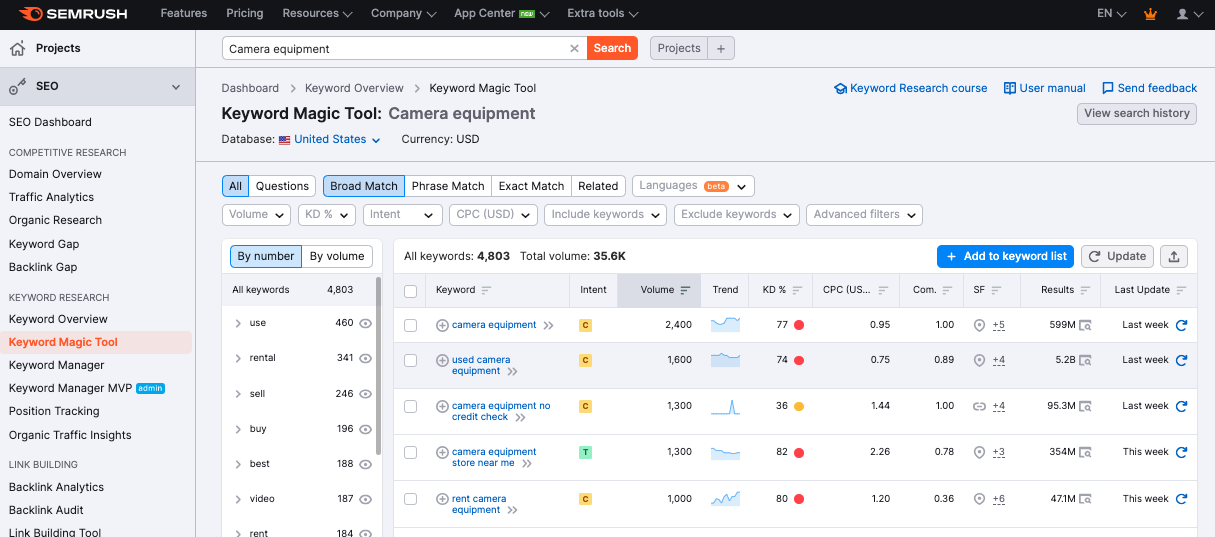
Key Takeaways from This Article
- Ecommerce Booster—Audit all three main areas of page performance: UX, visual content, and text content. Get an action plan to increase traffic and improve conversions.
- Shopify Finder—Get insights on 50+ million Shopify products and 100+ million AliExpress products that cover 40+ countries (AliExpress data is available with a Pro plan)
- Keyword Wizard for Amazon—Get access to a huge database of 200+ million keywords and smart filters, and find high-volume/low-competition terms to help you win in Amazon search
- Ecommerce Keyword Analytics—Learn the top-performing keywords for major retailers, find keywords that convert, and evaluate product potential
- DataHawk—Access fully customizable KPIs and dashboards that expand your ecommerce reporting and data management/workflows
Ecomhunt—Get a curation of the best new products every day with detailed analytics on profits, engagement, links, ads, targeting, and price
Do Competitor Analysis—Small Business Is Booming
To grow your business on marketplaces, you will need to consider tactics outside of advertising to get a real competitive advantage. Consider programs like editorial recommendations, search ads, social media, and email marketing strategies to expand your reach at a reasonable cost per acquisition.
— Will Haire, CEO & Founder at BellaVix
Instead of only looking at the direct competitors, look at the indirect or even the market leaders of other segments to understand what works for them. Sometimes, even your competitors might have excellent website traffic but might face conversion issues. So don’t blindly look at the direct competition that you decide on. Look at their approach if it’s as per the consumer perspectives, the market situation, and customer expectations for your industry and decide which competitor to pick up and what level of research can take you closer to your goals.
— Himani Kankaria, Founder at Missive Digital
The best way to grow your business is to outperform your competitors; be the website or brand your customers think of first when they have a problem.
But you can’t know if you’re beating the competition without doing extensive competitor analysis and research.
Ecommerce business is projected to soar. Online retail sales are expected to exceed $6.5 trillion by 2026. That means competition amongst small ecommerce businesses will likely be fierce over the next 12 months.
With so many emerging and growing small ecommerce businesses vying for the same customer base, competitor research becomes absolutely vital to the success of your business.
Fortunately, several tools and templates are available that make this research a simple, straightforward process.
First, make a list of your competitors. You can source this by looking at:
Organic search results
Paid search results
Googling your niche/industry with the phrase “near me”
Once you have your list compiled, focus on these top three things:
Price: What do their products cost?
Product: What exactly are they selling?
Advertising: How are they reaching their customers?
Then head to your competitors’ websites and take notes on each of these focus points.
You can keep track of what you find with this handy free template we have created.
When looking at the price of your competitors’ products, are they comparable? For example, take a look at these two websites, B&H and Adorama, that sell camera equipment. Both businesses sell a Nikon Z5 camera.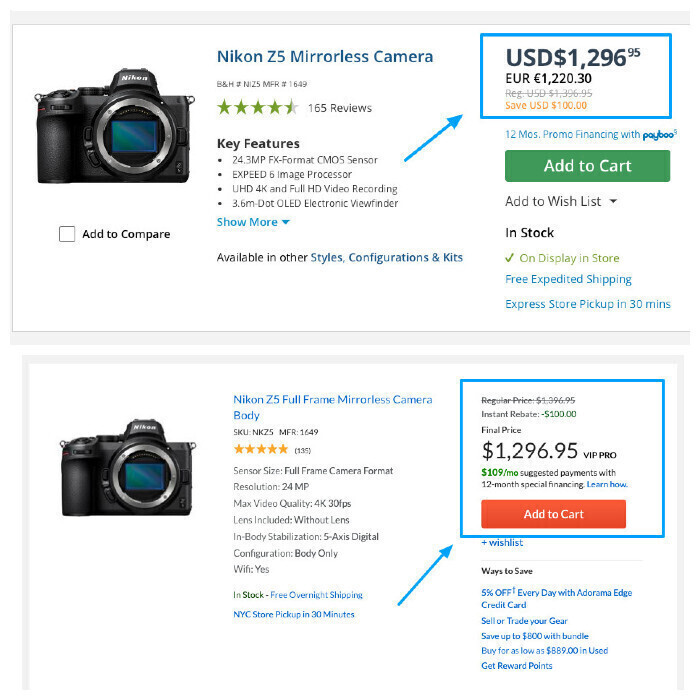
You’ll notice that both prices are identical, down to the cent.
Now, Nikon might control or set the price for retailers selling their cameras, but Adorama and B&H both offer packages, kits, and bundles that allow them to set unique price points.
This also benefits customers who need more than just a camera body to get started on their photography hobby.
When setting the prices for your own ecommerce business, consider packages and other special offers that will set you apart from your competitors.
This is especially important if your margins are tight and you don’t have much wiggle room on the base price of your items.
Discover Your market Potential
With Fernando Angulo, Senior Market Research Manager at Semrush
To scale your online business, you need to know what’s in your online market and be aware of other companies, products, or services that may threaten your expectations.
Why do market research?
Brands need real-time information about what’s happening in their industry. And they need to know what position they have in the market, how to expand their share, and what returns they can expect.
Having data from your industry can help you develop an effective marketing strategy (an example from the Market Explorer tool is featured below).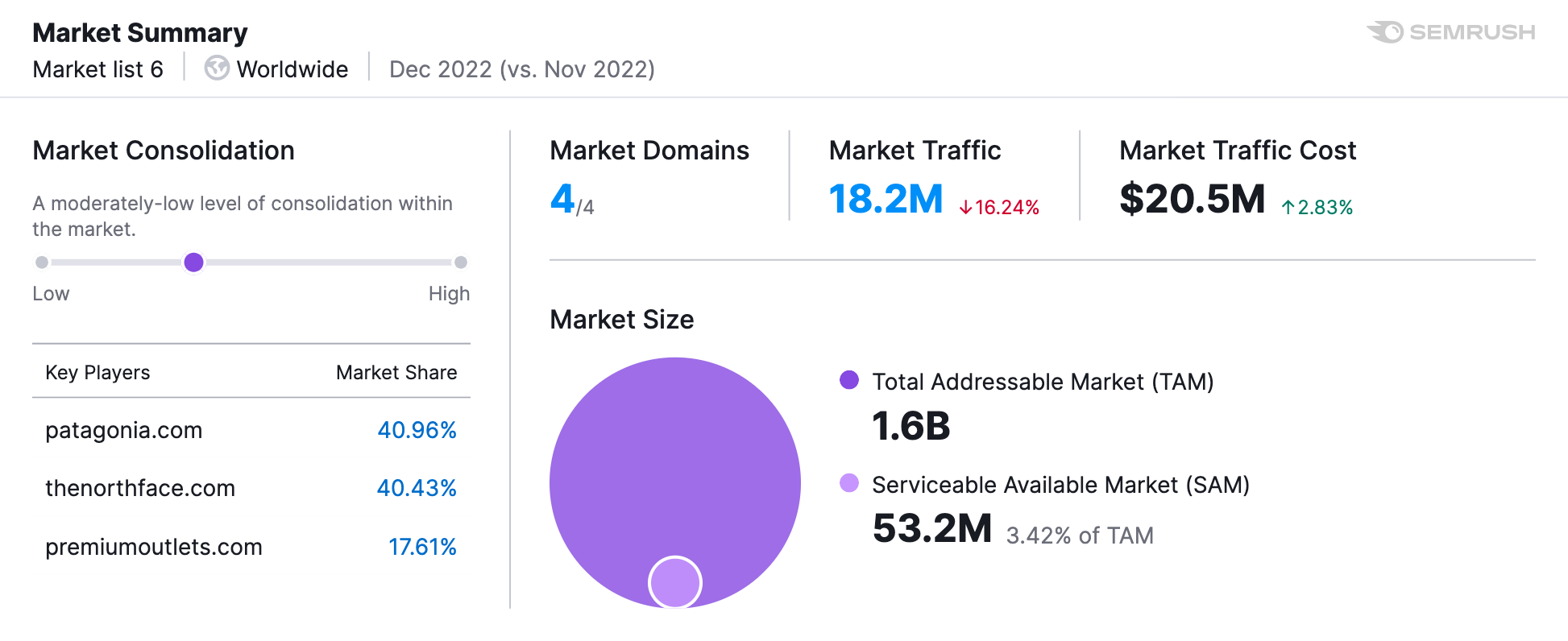
What aspects should be considered during the process?
The depth of your market research is up to you, but you should consider some key concepts such as:
Digital market share: The place your business occupies compared to the total market
Level of competition: The ease of competition in a given market is key to estimating the resources needed
Key players: The number and size of key players helps you know who you’re competing against and create innovative strategies
Market size: It’s not the same to have a potential market of 1,000 people as it is to have a million; the size of the market is key to defining its potential.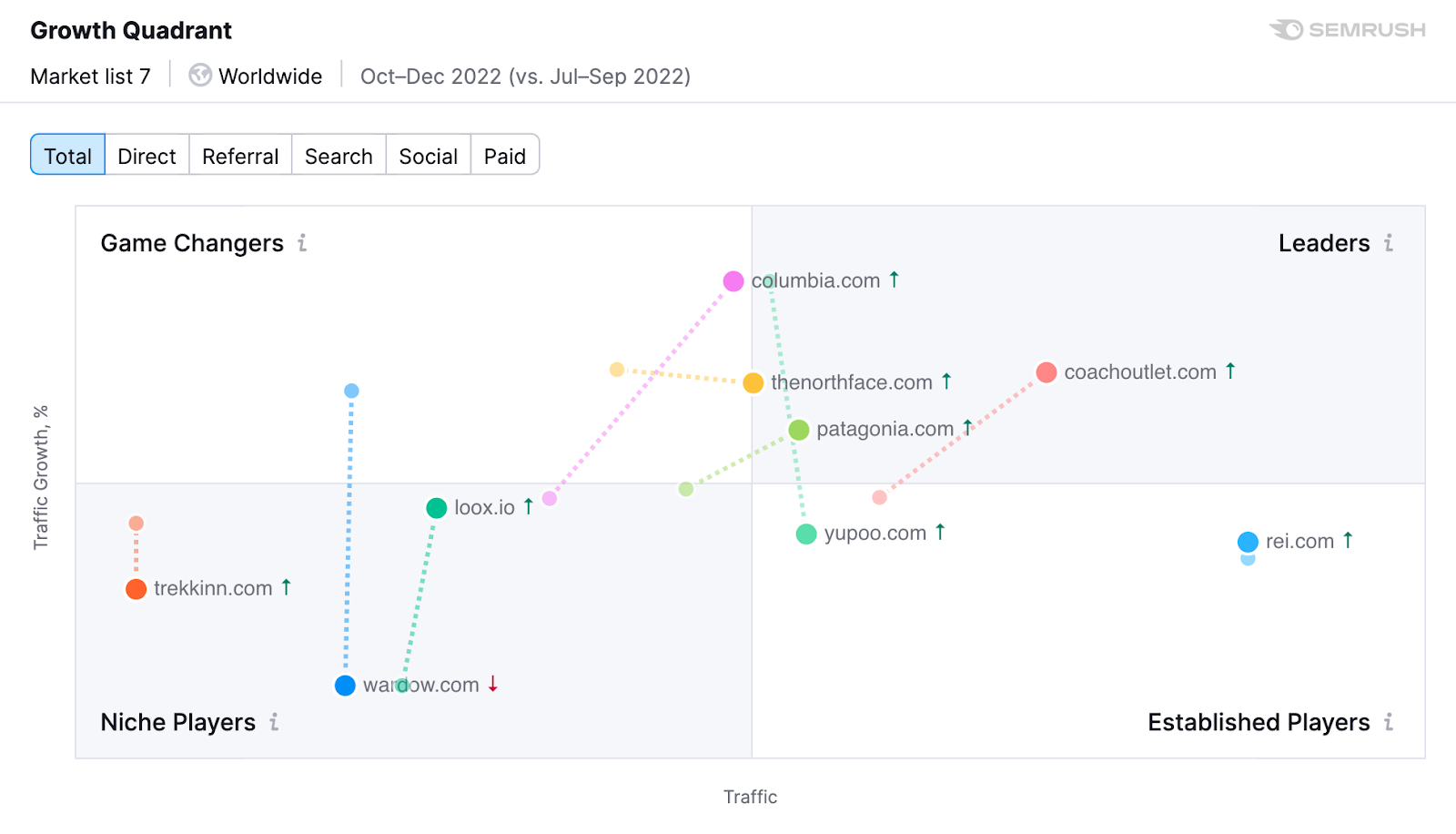
When we focus on the growth of our brand as compared with competitors, such as in the graphic above showing examples of The North Face, Patagonia, and Columbia, we must look at the reasons for such rapid growth and turn to a deeper analysis.
Paid and Organic Search Analysis of Competitors
Don’t overlook how your competitors are reaching their customers. What is their share of voice? Where do their ads appear in search, and how many high-value keywords are they ranking for in organic search?
These are all questions you’ll want to ask as you do your analysis. Thankfully, competitor analysis tools can help you do most of the heavy lifting.
For information on a breakdown of how your competitors get their traffic (paid vs. organic), go to the Benchmarking report in the Market Explorer tool.
Tools that can help:
- Trends—A competitive intelligence solution that is available with paid Semrush subscriptions (includes Traffic Analytics, Market Explorer, and EyeOn)
- EyeOn—Monitor your competitors’ online sales and marketing strategies 24/7
- AdClarity—Unwrap competitors’ digital ads, ad spend, and impressions
- Audience Intelligence—Discover in-depth consumer segmentation and cultural insights
- Klevu—Uncover shopper intent and help get your products discovered
- Koala Inspector Online ShopSpy app provides real-time tracking of your Shopify competitors, identifies top-performing apps, and offers insights into effective themes, enabling you to make data-driven decisions.
Commerce Inspector—Free Chrome extension that allows you to track any Shopify store’s product launches, best sellers, traffic, sales, ad campaigns, apps, and more
Maximize Your Traffic Performance
With Dan Saunders, Head of Performance Marketing | International Keynote Speaker & Judge
Adobe recently reported that 55 percent of marketers see data-driven marketing as their most important business opportunity, while 42 percent saw improving customer intelligence as a key priority. If your marketing initiatives are backed by data, you’re likely to see a much higher ROI—and there are a few ways you can use it to drive conversions.
Another competitor analysis tool you can leverage is the Advertising Research tool.
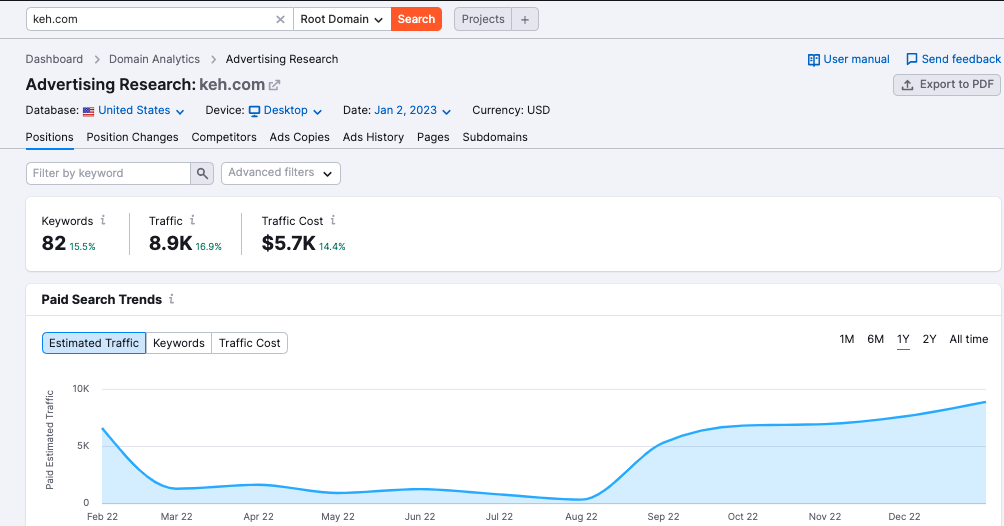
Influencer & Affiliate Marketing Are Crucial
Influencer and affiliate marketing has become huge in the last five or so years. If you haven’t delved into this world, it is a sales tactic that employs the use of popular influencers, third-party sites, and other brands to market your products for you.
A great recent example of influencer marketing that led to increased conversions (in this case downloading an app) was the partnership between Dunkin’ Donuts and influencer Charli D’Amelio.
D’Amelio became very popular on TikTok, and when Dunkin’ Donuts realized there could be a lucrative partnership potential, they created the custom Charli iced coffee drink.
This influencer partnership resulted in an over 56% percent increase in downloads of the Dunkin’ Donuts app.
The vast majority of influencer marketing now happens across social media networks like Facebook, Instagram, Twitter, and LinkedIn.
The benefits of influencer/affiliate marketing are numerous:
Access to an established, new acquisition channel via the brand or individual you choose to partner with
Potentially cheap advertisement—sometimes affiliate marketing relies on a quid pro quo system where a brand/influencer will write a review in return for free products or advertising their product/service on your social media accounts
Influencers are typically seen as trustworthy by their followers, so no need to spend a ton of money or time building up organic authority through your website
A network of affiliate partnerships, which opens your business to an evergreen channel of marketing opportunities
In particular, ecommerce brands can benefit from establishing strong relationships with influencers. Any time you release a new product, you can have a select group of influencers at the ready to test the product and provide an honest review on their social media pages.
If you’re in the market to build some new influencer connections, try an app like Influencer Analytics to help you:
Find influencers on social media looking to connect with business partners
Make strategic decisions based on influencers’ metrics
Get reports on an influencer/affiliate campaign’s performance
Create and deploy campaigns with social media influencers
Tools that can help:
- Influencer Analytics—Run, monitor, and analyze your influencer marketing campaigns all in one place
- Social Tracker—Lets you track the social media accounts of your closest competitors and compare their growth and engagement levels to yours
- Social Analytics—See your internal analytics metrics for your social media channels
- Captiv8—Find the best content creators to get your message out, execute campaigns, and analyze campaign performance
ReferralCandy—Reward customers for referrals and grow your sales by word-of-mouth marketing
Build a Responsive Customer Support Network
It is virtually inevitable when running an ecommerce business that you will encounter customer questions or concerns. Even the most conscientious, thoughtful businesses need to be ready to address these comments.
Building or growing a customer support arm of your ecommerce business should absolutely be a top priority in the coming year.
While it is great to have foundational solutions like chat support services, a customer care email address, and in some cases a call center, the competition for best customer service is going to be fierce in 2025.
That’s why some ecommerce businesses have opted to go above and beyond to retain and keep their customers happy.
Take CVS, for example. The large pharmaceutical company also operates an ecommerce site that sells everything from COVID-19 tests to supplements.
Recognizing its own huge product offering and that often these products are in the health and wellness space (which can be confusing to navigate), CVS set up a site full of educational resources.
Without scrolling far, customers can get support with a number of medication and medical-related questions and concerns.
CVS uses its website to provide multiple touch points for customers who might have questions about a prescription, or who maybe had an issue with a delivery and need to talk with someone about it.
CVS also encourages feedback with a dynamic tab that follows you as you scroll down the page.
In other words, CVS makes every effort to make it easy for customers to find what they are looking for and to contact a CVS representative should they encounter a problem.
Tools that can help:
- eDesk—An all-in-one help desk for ecommerce businesses; unify queries, orders, and customer info into a single view
- Sendinblue—Leverage live chat capabilities and chatbots to help customers solve problems quickly
- Gorgias—An ecommerce help desk that centralizes all support tickets into one convenient place
- Zendesk—A SaaS that helps you streamline your customer support process and handle tickets more efficiently
Make 2025 the Best Year Yet for Your Ecommerce Business
There are many reasons to be excited about the future of ecommerce business in 2025. Hopefully this article has illustrated that you as a marketer or business owner have virtually endless tools, tactics, and strategies at your disposal to make this your most successful year of business yet.
Go2Sell: Your Ecommerce Success Partner in the UAE
Are you ready to take your online business to new heights in the vibrant UAE market? Go2Sell offers a comprehensive e-commerce platform designed to help businesses of all sizes achieve their goals.
Key Benefits:
- Effortless Setup: Our user-friendly platform makes it easy to create and manage your online store without any technical expertise.
- Multilingual Storefronts: Reach a wider audience by offering your website in multiple languages.
- Global Payment Options: Accept payments from customers worldwide using a variety of payment methods.
- Simplified Shipping: Streamline your shipping process with integrated shipping solutions and real-time tracking.
- Powerful Marketing Tools: Boost your visibility and drive sales with built-in marketing features like SEO tools, email marketing, and social media integration.
- Data-Driven Insights: Gain valuable insights into your customers' behavior and preferences to optimize your marketing strategies.
- Dedicated Support: Our team of experts is always available to provide personalized assistance and guidance.
Why Choose Go2Sell?
- SME Focus: We specialize in catering to the needs of small and medium-sized enterprises, providing tailored solutions and support.
- User-Friendly Interface: Our platform is designed to be intuitive and easy to navigate, even for those with limited technical knowledge.
- Comprehensive Feature Set: We offer a wide range of features to help you manage every aspect of your online store, from product listings to customer support.
- Affordable Pricing: Our pricing plans are designed to be competitive and fit your budget.
- Dedicated Support: Our team of experts is always available to provide personalized assistance and guidance.
Experience the Go2Sell Difference:
- Effortless Setup: Get your online store up and running in no time.
- Scalability: Our platform grows with your business, accommodating increasing traffic and sales volumes.
- Customer Focus: We prioritize customer satisfaction and provide exceptional support.
- Data-Driven Insights: Make informed decisions based on valuable data analytics.
Ready to take your business to the next level?
Start your FREE 90-day trial of Go2Sell today and experience the power of our data-driven platform.
Also Read:
- Finding the perfect fir for your ecommerce business.
- The ultimate guide to social media for ecommerce.
Ref. taken from:
- Semrush Blog: Grow your ecommerce business.
- Nasir, A., & Khan, M. A. (2019). The Future of E-Commerce: Trends and Predictions for 2025.
- Smith, A. (2018). E-Commerce Growth Trends and Forecasts for 2025.
- Bharadwaj, A., & Dabhade, V. (2019). The Role of Artificial Intelligence in Shaping the Future of E-Commerce.
- Voronov, A., & Gupta, A. (2019). Virtual and Augmented Reality in E-Commerce: A Review and Agenda for Future Research.
- Sharma, R., & Shrivastava, D. (2019). Blockchain Technology in E-Commerce: A Systematic Review and Agenda for Future Research.
FAQs
Question 1: What is the current state of ecommerce in 2021?
Answer: As of 2021, ecommerce is growing rapidly, with global retail ecommerce sales reaching $4.9 trillion. The COVID-19 pandemic has accelerated the growth of ecommerce, as more consumers are shopping online for convenience and safety reasons.
Question 2: What are the key drivers of ecommerce growth in 2025?
Answer: The key drivers of ecommerce growth in 2025 include:
- Increasing internet penetration and smartphone adoption
- Growing consumer preference for online shopping
- Advances in technology, such as artificial intelligence and virtual reality
- Government initiatives to promote digitalization
- Growing competition among ecommerce players, leading to better deals and customer experiences
Question 3: What are the challenges faced by the ecommerce industry in 2025?
Answer: The challenges faced by the ecommerce industry in 2025 include:
- Competition from traditional brick-and-mortar stores
- High customer acquisition and retention costs
- Supply chain and logistics challenges
- Data security and privacy concerns
- Regulatory and legal compliance
Question 4: What are the most important trends to watch in ecommerce in 2025?
Answer: The most important trends to watch in ecommerce in 2025 include:
- Growth of mobile commerce
- Increasing adoption of artificial intelligence and machine learning
- Expansion of voice commerce
- Development of virtual and augmented reality technologies
- Focus on sustainability and eco-friendly practices
Question 5: How can businesses prepare for the future of ecommerce in 2025?
Answer: Businesses can prepare for the future of ecommerce in 2025 by:
- Developing a strong online presence
- Investing in user-friendly website design and user experience
- Leveraging social media platforms for marketing and sales
- Offering seamless and secure payment options
- Focusing on customer service and retention
- Staying updated on industry trends and innovations
Question 6: What are the potential opportunities for ecommerce businesses in 2025?
Answer: Potential opportunities for ecommerce businesses in 2025 include:
- Expansion into new markets and customer segments
- Collaboration with influencers and content creators
- Adoption of new technologies, such as AI and VR
- Optimization of supply chain and logistics operations
- Enhancement of customer experience through personalization and targeted marketing
Question 7: How can ecommerce businesses ensure their success in 2025?
Answer: Ecommerce businesses can ensure their success in 2025 by:
- Staying focused on customer needs and preferences
- Continuously improving and optimizing their online presence
- Investing in cutting-edge technology and innovation
- Building strong partnerships with suppliers and logistics providers
- Committing to sustainability and social responsibility initiatives
Question 8: What are the key performance indicators (KPIs) to track for ecommerce success in 2025?
Answer: Key performance indicators (KPIs) to track for ecommerce success in 2025 include:
- Gross merchandise value (GMV)
- Average order value (AOV)
- Conversion rate
- Customer acquisition cost (CAC)
- Customer lifetime value (CLV)
- Return on investment (ROI)
- Social media engagement and follower growth
Question 9: How can ecommerce businesses effectively market their products and services in 2025?
Answer: Ecommerce businesses can effectively market their products and services in 2025 by:
- Leveraging social media platforms and influencer marketing
- Implementing content marketing strategies, such as blogging and vlogging
- Utilizing email marketing and customer segmentation
- Investing in search engine optimization (SEO) and pay-per-click (PPC) advertising
- Hosting giveaways and promotions to drive customer engagement
Question 10: What are the must-have tools and software for ecommerce businesses in 2025?
Answer: Must-have tools and software for ecommerce businesses in 2025 include:
- Ecommerce platform and web hosting
- Inventory management and order fulfillment software
- Customer relationship management (CRM) software
- Marketing automation and analytics tools
- Payment processing and security solutions
- Shipping and logistics management software
Question 11: What is the easiest eCommerce platform for beginners?
Answer: Platforms like Go2sell, Fathershops, BigCommerce, and Wix are designed for users without technical skills. They offer drag-and-drop builders and pre-designed templates, making it easy to set up an online store. However, if you need a highly customized site or specific integrations, some technical knowledge might be beneficial.